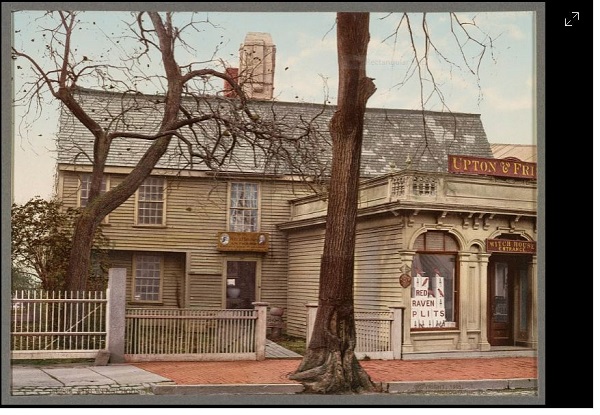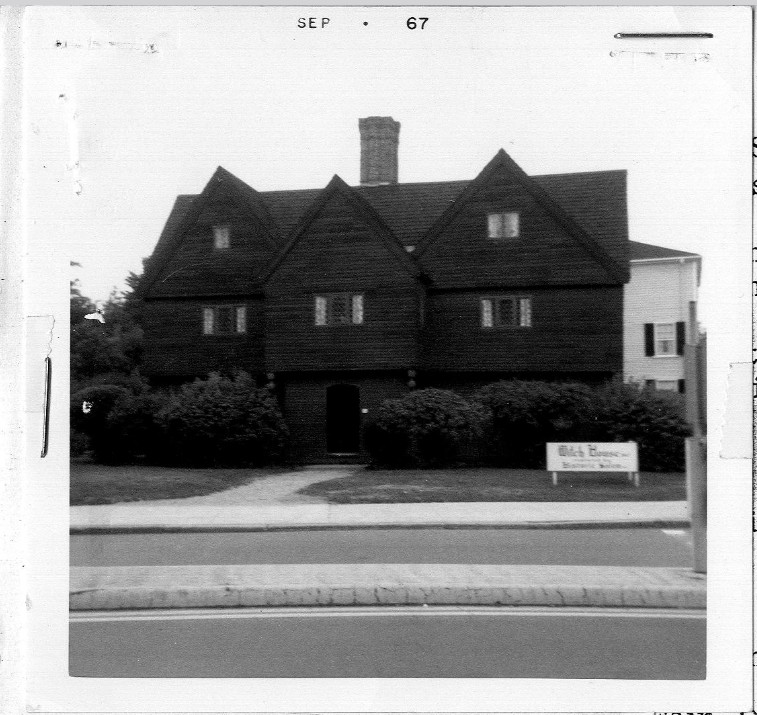The Witch House, also known as the Jonathan Corwin House, is a historic First-Period house on Essex Street in Salem, Massachusetts.
It was the home of Salem Witch Judge Jonathan Corwin and is the only structure open to the public in Salem with direct ties to the Salem Witch Trials.
The house is a two-and-a-half-story, wooden clapboard house with a center chimney and a gable roof. It features a two-story entry porch, a second-story overhang with pendant drops, diamond-paned casement windows, and a lean-to addition in the rear.
The house was built in 1675 for Captain Nathaniel Davenport, who then moved to Boston before he finished building it.
In 1675, Davenport sold the partially constructed house to Judge Jonathan Corwin, who then completed it and moved in with his wife and children.
Some historians used to believe that the house was built in the 1630s and that religious leader Roger Williams lived in the house while he was preaching in Salem.
As a result, there are a lot of 19th-century and early-20th-century photos, drawings, and documents that refer to the house as the Roger Williams House.
The reason they believed this was due to a town document from 1714, according to an Essex Institute Historical Collections periodical:
“In 1714, Jonathan Corwin was allowed two shares in the common lands ‘for his house and Mr. Williams cottage right.’ That is to say, it was proved, in 1714, to the satisfaction of the Proprietors of the Common Lands in Salem that ‘Mr. Williams’ had lived before 1661 where Jonathan Corwin was then living. The ten acre lot in the Northfield which went with this house in the sale to Corwin is shown to have belonged to ‘Mr. Williams’…That ‘Mr. Williams’ meant Roger Williams cannot be doubted. It is clear that it was perfectly understood at the time whom the expression applied. If there had been more than one Mr. Williams in Salem’s early history, the records would not have so invariably omitted the first name. But there was, in fact, no other to whom that title would have been given. The prefix ‘Mr.’ was used only for magistrates, ministers, eminent merchants and persons holding some official position. The only other ‘Mr. Williams’ who figures in our Colonial records at that period was Francis Williams of Piscataqua and Strawberry Bank, now Portsmouth.”
Historians now believe the house was instead built in 1675, which was decades after Williams was banished from Salem in 1635.
Some sources also state that a few of the pretrial examinations of the Salem Witch Trials may have been conducted in the house when Corwin lived there. There is no mention of the house being used for the examinations in any of the primary sources on witch trials, but it is possible that it may have happened.
Witch House in the 18th Century:
Jonathan Corwin lived in the house for 40 years until his death in 1718. Even after Corwin’s death, the house remained in the Corwin family for many generations.
Alterations were made to the house after Corwin’s grandson, George, died in 1746, and his widow removed the gables from the house, added some extra rooms, and replaced the peaked roof with a gambrel that covered the entire frame.
Witch House in the 19th Century:
Sarah Ward Cushing, the last Corwin descendant to live in the house, owned the house from 1836 until she sold it to a pharmacist named George Farrington in 1851.
Farrington added an apothecary to the side of the building and an addition to the southeast corner of the building sometime around 1851.
Some sources state that Farrington was the first person to call the house the Witch House when he was trying to promote his pharmacy business there. There are numerous newspaper ads from the 19th century for Farrington’s apothecary that mention the house as the “Old Witch House.”
Yet, other sources state that locals started calling it the Witch House long before because of its ties to the Salem Witch Trials, and the name simply stuck.

More renovations were made to the house sometime between 1851 and 1874, including the construction of an additional rear ell. Even more additions were made to the rear of the house by 1897.
In April 1899, a fire started in a plumbing shop in an 18th-century building next door to the Witch House, but the blaze was extinguished before it spread.
Around the turn of the century, the house was divided into two separate commercial spaces. Upton & Frisbee owned and operated a drugstore in the house, and the second space was home to an antique store, called Witch House Antiques, which was owned by Grace Atkinson.
Witch House in the 20th Century:
In August of 1900, a 27-year-old woman named Carrie Peabody Bly began frequenting the Witch House and claimed she was bewitched by spirits in the house and could communicate with them.
Bly reportedly spent every day either in the upper chamber of the house or in the garret of the house holding communion with the spirits, including the spirits of Nathaniel Hawthorne and Betsy Williams.
In March 1924, the Witch House was damaged during a fire that started in a laundromat next door. A protecting wall prevented the fire from spreading to the first floor of the house, but it leaped to the second floor and garret and burned through part of the roof before it was stopped. The building suffered smoke and water damage, but rubber blankets were used to protect the antiques.
On February 15, 1942, a fire in a nearby cobbler shop on North Street spread to the laundromat adjoining the Witch House, but firefighters were able to put out the blaze with only slight damage to the historic house.

In 1944, the house was slated for demolition when the street it was located on, North Street, needed to be widened. A group of local citizens formed an organization called Historic Salem Inc. and raised funds to help move the house back 35 feet from North Street to its present location on Essex Street.
Around the same time, the house was restored to its 17th-century appearance by Historic Salem Inc. under the direction of Boston architect Gordon Robb, with the assistance of architect Frank C. Brown, and it was turned over to the city of Salem. It opened as a historic house museum in 1946.
In 1947, the Boston Post reported that a merchant in London, England, was selling “Witch Sticks,” which were twigs that reportedly came from a bush on the lawn of the Witch House that were shaped into a witch’s face.
In 1978, a replica of the Witch House was built in Hollis, NH. In 1984, another replica of the Witch House was built in Sandwich, Massachusetts, and in 1995, another replica was built in Huntsville, Alabama.
The Witch House is currently owned and operated by the City of Salem Park and Recreation Department and is listed as a contributing property on the National Register of Historic Places.
Sources:
“The Observant Citizen.” Boston Post, 30 Mar. 1947, p. 26.
“Witch House/Corwin House.” Salem Heritage Trail, salemheritagetrail.org/locations/corwin-house/
“Salem Restores Famed Witch House.” The Boston Globe, 25 Aug. 1946, 20-A.
“Salem Witch House Endangered.” Daily Evening Item (Lynn), 12 Apr. 1899, p. 4.
“Claims She Is Bewitched.” The Providence News, 9 Aug. 1900, p. 5.
“Salem ‘Witch House’ Burns.” New York Evening Post, 28 Mar. 1924, p. 16.
“Old Salem Witch House in Flames.” The Boston Herald, 28 March 1924. p. 1.
“Salem ‘Witch House’ Burns.” The Boston Evening Transcript, 28 March 1924.
“Salem ‘Witch House’ Burns.” Prescott Evening Currier, 2 May. 1924. p. 4.
“Fire Perils Old Salem Witch House.” Boston Record, 16 Feb. 1942. p. 14.
“Historic Building Detail: SAL.1510 Corwin, Judge Jonathan House.” MACRIS, mhc-macris.net/details?mhcid=SAL.1510
Historical Collections of the Essex Institute, Vol. XXIV, Essex Institute, 1859, archive.org/details/historicalcollec24esse/page/n5/mode/2up
Livermore, Sienna. “You Can Now Live in a Replica of the Salem Witch House.” House Beautiful, 31 Oct. 2018, housebeautiful.com/lifestyle/a24482749/salem-witch-house-replica/
“A look inside Alabama’s Witch House, replica of a 17th-century Salem home.” Alabama Living, al.com/living/2015/10/a_look_inside_alabamas_witch_h.html
Ocker, J.W. “A Witch House in the Wrong State.” New Hampshire Magazine, 28 May. 2009, nhmagazine.com/a-witch-house-in-the-wrong-state-the-new-hampshire-witch-house/

